Elements of Negligence and Legal Liability: A Comprehensive Report
VerifiedAdded on 2020/05/16
|9
|2059
|84
Report
AI Summary
This report provides a comprehensive analysis of the elements of negligence under Australian common law, using the case study of Josh Marsh and Wajiha. It examines the key components of negligence, including duty of care, breach of duty, causation, and the foreseeability of harm. The report references landmark cases such as Donoghue v Stevenson, Caparo Industries plc v Dickman, and Anns v Merton London Borough Council to illustrate legal principles. It applies these principles to assess Josh's liability for Wajiha's injuries, considering factors such as the condition of the ATV, Josh's actions in increasing speed, and the potential for contributory negligence on Wajiha's part. The analysis concludes that Josh was negligent and potentially liable, while also considering the implications of contributory negligence on any damages claimed by Wajiha. The report emphasizes the importance of establishing a duty of care, its breach, and the causal link between the breach and the resulting harm, alongside the potential for contributory negligence to affect the outcome.
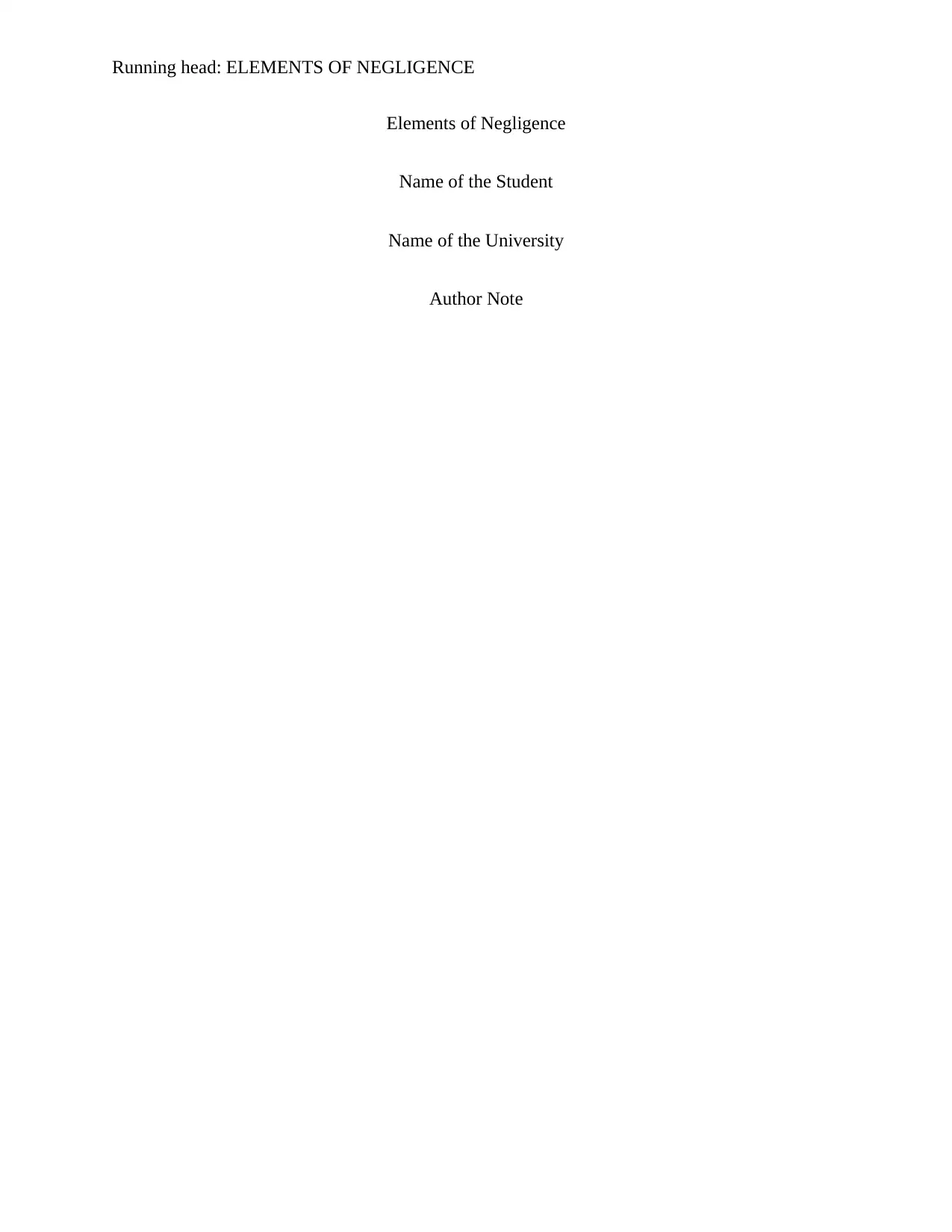
Running head: ELEMENTS OF NEGLIGENCE
Elements of Negligence
Name of the Student
Name of the University
Author Note
Elements of Negligence
Name of the Student
Name of the University
Author Note
Paraphrase This Document
Need a fresh take? Get an instant paraphrase of this document with our AI Paraphraser
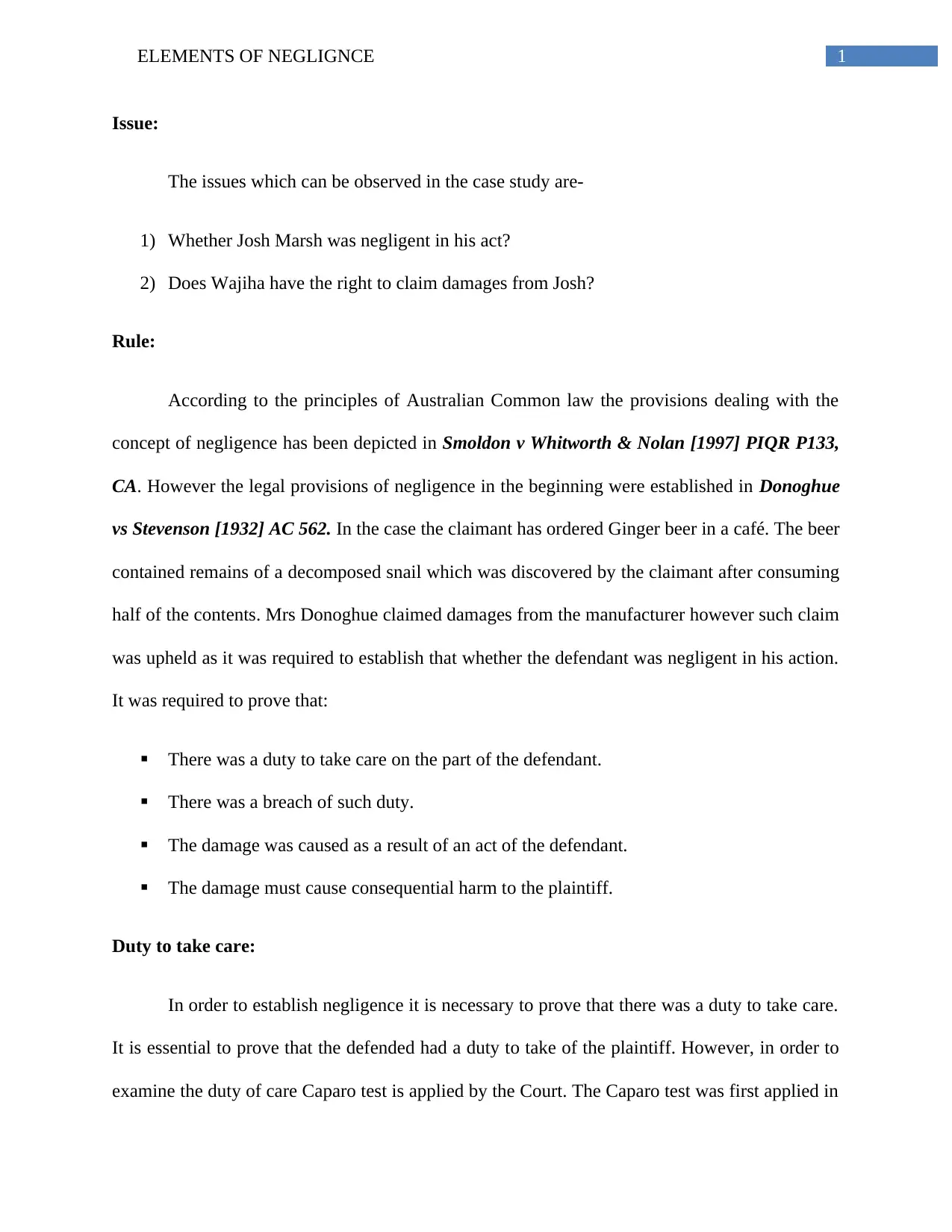
1ELEMENTS OF NEGLIGNCE
Issue:
The issues which can be observed in the case study are-
1) Whether Josh Marsh was negligent in his act?
2) Does Wajiha have the right to claim damages from Josh?
Rule:
According to the principles of Australian Common law the provisions dealing with the
concept of negligence has been depicted in Smoldon v Whitworth & Nolan [1997] PIQR P133,
CA. However the legal provisions of negligence in the beginning were established in Donoghue
vs Stevenson [1932] AC 562. In the case the claimant has ordered Ginger beer in a café. The beer
contained remains of a decomposed snail which was discovered by the claimant after consuming
half of the contents. Mrs Donoghue claimed damages from the manufacturer however such claim
was upheld as it was required to establish that whether the defendant was negligent in his action.
It was required to prove that:
There was a duty to take care on the part of the defendant.
There was a breach of such duty.
The damage was caused as a result of an act of the defendant.
The damage must cause consequential harm to the plaintiff.
Duty to take care:
In order to establish negligence it is necessary to prove that there was a duty to take care.
It is essential to prove that the defended had a duty to take of the plaintiff. However, in order to
examine the duty of care Caparo test is applied by the Court. The Caparo test was first applied in
Issue:
The issues which can be observed in the case study are-
1) Whether Josh Marsh was negligent in his act?
2) Does Wajiha have the right to claim damages from Josh?
Rule:
According to the principles of Australian Common law the provisions dealing with the
concept of negligence has been depicted in Smoldon v Whitworth & Nolan [1997] PIQR P133,
CA. However the legal provisions of negligence in the beginning were established in Donoghue
vs Stevenson [1932] AC 562. In the case the claimant has ordered Ginger beer in a café. The beer
contained remains of a decomposed snail which was discovered by the claimant after consuming
half of the contents. Mrs Donoghue claimed damages from the manufacturer however such claim
was upheld as it was required to establish that whether the defendant was negligent in his action.
It was required to prove that:
There was a duty to take care on the part of the defendant.
There was a breach of such duty.
The damage was caused as a result of an act of the defendant.
The damage must cause consequential harm to the plaintiff.
Duty to take care:
In order to establish negligence it is necessary to prove that there was a duty to take care.
It is essential to prove that the defended had a duty to take of the plaintiff. However, in order to
examine the duty of care Caparo test is applied by the Court. The Caparo test was first applied in
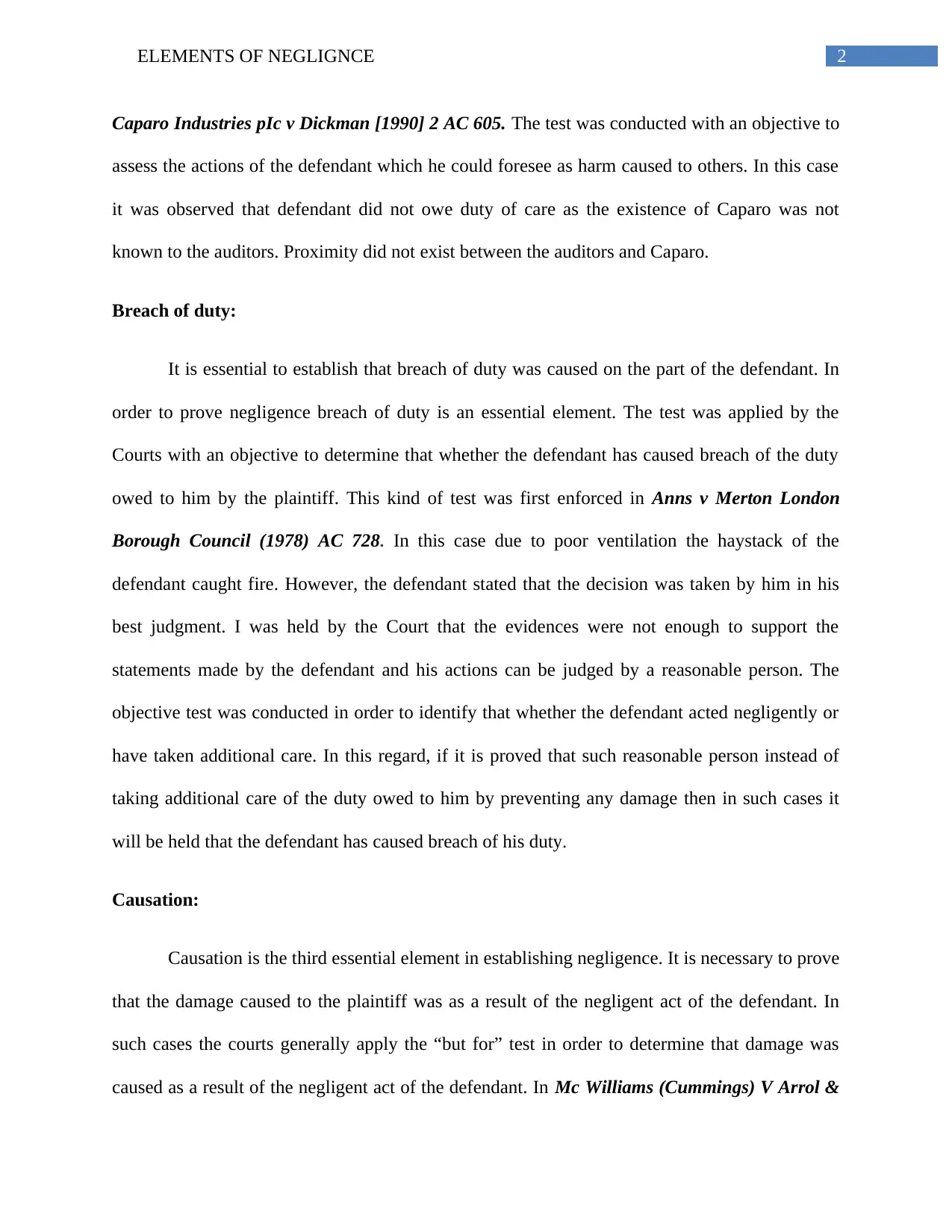
2ELEMENTS OF NEGLIGNCE
Caparo Industries pIc v Dickman [1990] 2 AC 605. The test was conducted with an objective to
assess the actions of the defendant which he could foresee as harm caused to others. In this case
it was observed that defendant did not owe duty of care as the existence of Caparo was not
known to the auditors. Proximity did not exist between the auditors and Caparo.
Breach of duty:
It is essential to establish that breach of duty was caused on the part of the defendant. In
order to prove negligence breach of duty is an essential element. The test was applied by the
Courts with an objective to determine that whether the defendant has caused breach of the duty
owed to him by the plaintiff. This kind of test was first enforced in Anns v Merton London
Borough Council (1978) AC 728. In this case due to poor ventilation the haystack of the
defendant caught fire. However, the defendant stated that the decision was taken by him in his
best judgment. I was held by the Court that the evidences were not enough to support the
statements made by the defendant and his actions can be judged by a reasonable person. The
objective test was conducted in order to identify that whether the defendant acted negligently or
have taken additional care. In this regard, if it is proved that such reasonable person instead of
taking additional care of the duty owed to him by preventing any damage then in such cases it
will be held that the defendant has caused breach of his duty.
Causation:
Causation is the third essential element in establishing negligence. It is necessary to prove
that the damage caused to the plaintiff was as a result of the negligent act of the defendant. In
such cases the courts generally apply the “but for” test in order to determine that damage was
caused as a result of the negligent act of the defendant. In Mc Williams (Cummings) V Arrol &
Caparo Industries pIc v Dickman [1990] 2 AC 605. The test was conducted with an objective to
assess the actions of the defendant which he could foresee as harm caused to others. In this case
it was observed that defendant did not owe duty of care as the existence of Caparo was not
known to the auditors. Proximity did not exist between the auditors and Caparo.
Breach of duty:
It is essential to establish that breach of duty was caused on the part of the defendant. In
order to prove negligence breach of duty is an essential element. The test was applied by the
Courts with an objective to determine that whether the defendant has caused breach of the duty
owed to him by the plaintiff. This kind of test was first enforced in Anns v Merton London
Borough Council (1978) AC 728. In this case due to poor ventilation the haystack of the
defendant caught fire. However, the defendant stated that the decision was taken by him in his
best judgment. I was held by the Court that the evidences were not enough to support the
statements made by the defendant and his actions can be judged by a reasonable person. The
objective test was conducted in order to identify that whether the defendant acted negligently or
have taken additional care. In this regard, if it is proved that such reasonable person instead of
taking additional care of the duty owed to him by preventing any damage then in such cases it
will be held that the defendant has caused breach of his duty.
Causation:
Causation is the third essential element in establishing negligence. It is necessary to prove
that the damage caused to the plaintiff was as a result of the negligent act of the defendant. In
such cases the courts generally apply the “but for” test in order to determine that damage was
caused as a result of the negligent act of the defendant. In Mc Williams (Cummings) V Arrol &
⊘ This is a preview!⊘
Do you want full access?
Subscribe today to unlock all pages.

Trusted by 1+ million students worldwide
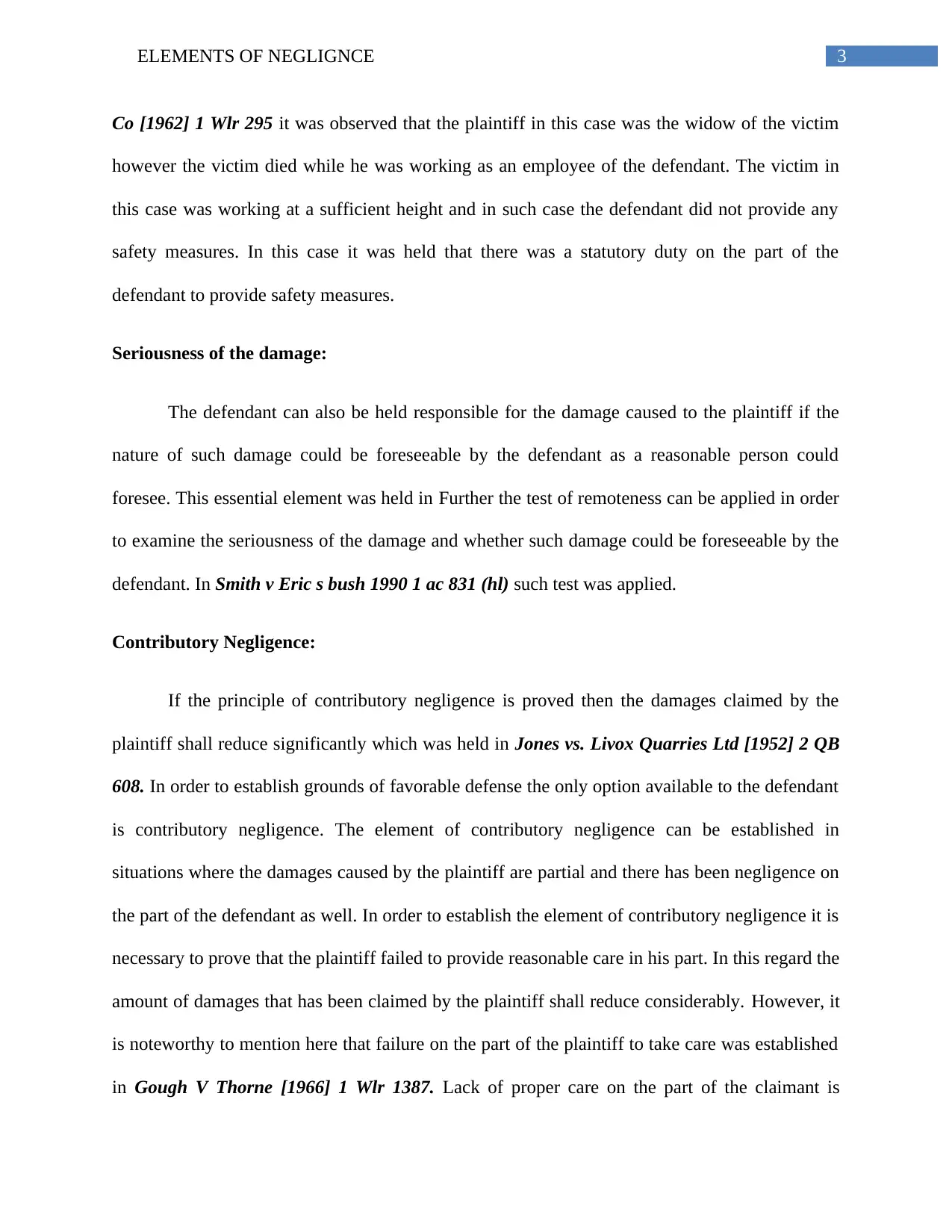
3ELEMENTS OF NEGLIGNCE
Co [1962] 1 Wlr 295 it was observed that the plaintiff in this case was the widow of the victim
however the victim died while he was working as an employee of the defendant. The victim in
this case was working at a sufficient height and in such case the defendant did not provide any
safety measures. In this case it was held that there was a statutory duty on the part of the
defendant to provide safety measures.
Seriousness of the damage:
The defendant can also be held responsible for the damage caused to the plaintiff if the
nature of such damage could be foreseeable by the defendant as a reasonable person could
foresee. This essential element was held in Further the test of remoteness can be applied in order
to examine the seriousness of the damage and whether such damage could be foreseeable by the
defendant. In Smith v Eric s bush 1990 1 ac 831 (hl) such test was applied.
Contributory Negligence:
If the principle of contributory negligence is proved then the damages claimed by the
plaintiff shall reduce significantly which was held in Jones vs. Livox Quarries Ltd [1952] 2 QB
608. In order to establish grounds of favorable defense the only option available to the defendant
is contributory negligence. The element of contributory negligence can be established in
situations where the damages caused by the plaintiff are partial and there has been negligence on
the part of the defendant as well. In order to establish the element of contributory negligence it is
necessary to prove that the plaintiff failed to provide reasonable care in his part. In this regard the
amount of damages that has been claimed by the plaintiff shall reduce considerably. However, it
is noteworthy to mention here that failure on the part of the plaintiff to take care was established
in Gough V Thorne [1966] 1 Wlr 1387. Lack of proper care on the part of the claimant is
Co [1962] 1 Wlr 295 it was observed that the plaintiff in this case was the widow of the victim
however the victim died while he was working as an employee of the defendant. The victim in
this case was working at a sufficient height and in such case the defendant did not provide any
safety measures. In this case it was held that there was a statutory duty on the part of the
defendant to provide safety measures.
Seriousness of the damage:
The defendant can also be held responsible for the damage caused to the plaintiff if the
nature of such damage could be foreseeable by the defendant as a reasonable person could
foresee. This essential element was held in Further the test of remoteness can be applied in order
to examine the seriousness of the damage and whether such damage could be foreseeable by the
defendant. In Smith v Eric s bush 1990 1 ac 831 (hl) such test was applied.
Contributory Negligence:
If the principle of contributory negligence is proved then the damages claimed by the
plaintiff shall reduce significantly which was held in Jones vs. Livox Quarries Ltd [1952] 2 QB
608. In order to establish grounds of favorable defense the only option available to the defendant
is contributory negligence. The element of contributory negligence can be established in
situations where the damages caused by the plaintiff are partial and there has been negligence on
the part of the defendant as well. In order to establish the element of contributory negligence it is
necessary to prove that the plaintiff failed to provide reasonable care in his part. In this regard the
amount of damages that has been claimed by the plaintiff shall reduce considerably. However, it
is noteworthy to mention here that failure on the part of the plaintiff to take care was established
in Gough V Thorne [1966] 1 Wlr 1387. Lack of proper care on the part of the claimant is
Paraphrase This Document
Need a fresh take? Get an instant paraphrase of this document with our AI Paraphraser
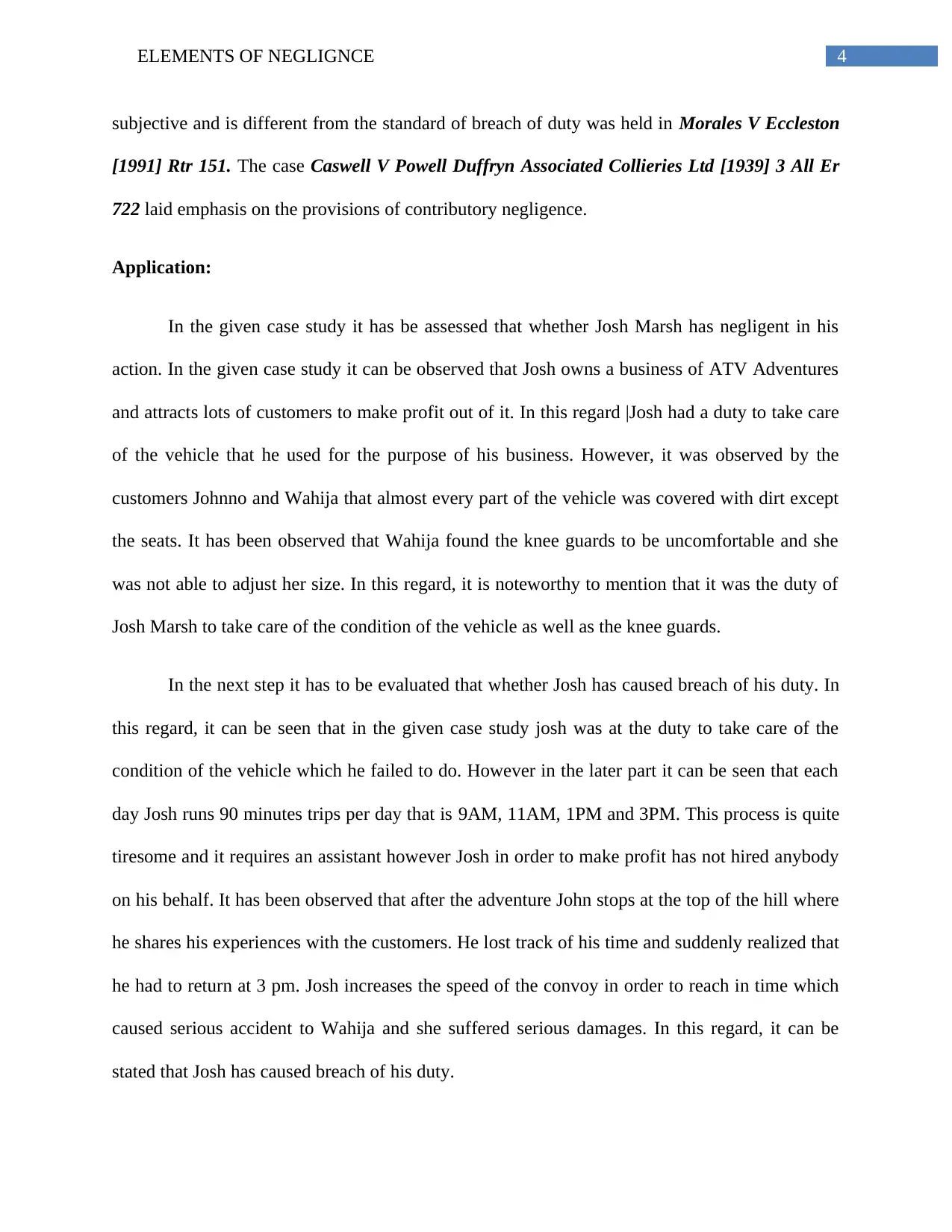
4ELEMENTS OF NEGLIGNCE
subjective and is different from the standard of breach of duty was held in Morales V Eccleston
[1991] Rtr 151. The case Caswell V Powell Duffryn Associated Collieries Ltd [1939] 3 All Er
722 laid emphasis on the provisions of contributory negligence.
Application:
In the given case study it has be assessed that whether Josh Marsh has negligent in his
action. In the given case study it can be observed that Josh owns a business of ATV Adventures
and attracts lots of customers to make profit out of it. In this regard |Josh had a duty to take care
of the vehicle that he used for the purpose of his business. However, it was observed by the
customers Johnno and Wahija that almost every part of the vehicle was covered with dirt except
the seats. It has been observed that Wahija found the knee guards to be uncomfortable and she
was not able to adjust her size. In this regard, it is noteworthy to mention that it was the duty of
Josh Marsh to take care of the condition of the vehicle as well as the knee guards.
In the next step it has to be evaluated that whether Josh has caused breach of his duty. In
this regard, it can be seen that in the given case study josh was at the duty to take care of the
condition of the vehicle which he failed to do. However in the later part it can be seen that each
day Josh runs 90 minutes trips per day that is 9AM, 11AM, 1PM and 3PM. This process is quite
tiresome and it requires an assistant however Josh in order to make profit has not hired anybody
on his behalf. It has been observed that after the adventure John stops at the top of the hill where
he shares his experiences with the customers. He lost track of his time and suddenly realized that
he had to return at 3 pm. Josh increases the speed of the convoy in order to reach in time which
caused serious accident to Wahija and she suffered serious damages. In this regard, it can be
stated that Josh has caused breach of his duty.
subjective and is different from the standard of breach of duty was held in Morales V Eccleston
[1991] Rtr 151. The case Caswell V Powell Duffryn Associated Collieries Ltd [1939] 3 All Er
722 laid emphasis on the provisions of contributory negligence.
Application:
In the given case study it has be assessed that whether Josh Marsh has negligent in his
action. In the given case study it can be observed that Josh owns a business of ATV Adventures
and attracts lots of customers to make profit out of it. In this regard |Josh had a duty to take care
of the vehicle that he used for the purpose of his business. However, it was observed by the
customers Johnno and Wahija that almost every part of the vehicle was covered with dirt except
the seats. It has been observed that Wahija found the knee guards to be uncomfortable and she
was not able to adjust her size. In this regard, it is noteworthy to mention that it was the duty of
Josh Marsh to take care of the condition of the vehicle as well as the knee guards.
In the next step it has to be evaluated that whether Josh has caused breach of his duty. In
this regard, it can be seen that in the given case study josh was at the duty to take care of the
condition of the vehicle which he failed to do. However in the later part it can be seen that each
day Josh runs 90 minutes trips per day that is 9AM, 11AM, 1PM and 3PM. This process is quite
tiresome and it requires an assistant however Josh in order to make profit has not hired anybody
on his behalf. It has been observed that after the adventure John stops at the top of the hill where
he shares his experiences with the customers. He lost track of his time and suddenly realized that
he had to return at 3 pm. Josh increases the speed of the convoy in order to reach in time which
caused serious accident to Wahija and she suffered serious damages. In this regard, it can be
stated that Josh has caused breach of his duty.

5ELEMENTS OF NEGLIGNCE
The third essential element that has to be proved is that whether the damages were caused
as the result of the action of the plaintiff. In the present case study it can be seen that Josh has
increased the speed of the convoy and it was well known to him that such step could cause
serious accident. The nature of the action of Josh was such that it would likely to cause damage.
It can be seen that in this case the negligent was wholly on the part of Josh. In order to run this
tiresome business he at least needs assistance however he has not hired any employee in order to
gain profit. In order to reach the cabin on time he increased the speed of the vehicle and the
passengers met with an accident by causing serious injury especially to Wahija.
The fourth essential element is to prove that whether the nature of the negligent act was
such as it could reasonable be foreseeable by the defendant. In the present case study it can be
observed that john increased the speed of the vehicle to a great extent and opted for a shortcut
which was reserved only for experienced drivers. It can be observed that though Josh was a
experienced driver, he knew that if the speed of the vehicle is increased considerably it could
cause accident and the lives of the customers will be at danger. It can be observed that in spite of
having knowledge about the consequences of such step Josh increased the speed of the vehicle
because he had to reach the cabin on time. Therefore in the present case study it can be
established that Josh was negligent on his part because he could foresee the consequences of his
actions as it could be foreseeable by a reasonable person.
It can be observed that in the present case study one particular defense was available to
the defendant that is the element of contributory negligence. In the present case study it can be
observed that Wahija knew that the knee guards were comfortable and did not fit her however
she relied on Johnno as he was a good driver. In this regard, it is noteworthy to mention that if
the provision of contributory negligence could be established then the amount of damages
The third essential element that has to be proved is that whether the damages were caused
as the result of the action of the plaintiff. In the present case study it can be seen that Josh has
increased the speed of the convoy and it was well known to him that such step could cause
serious accident. The nature of the action of Josh was such that it would likely to cause damage.
It can be seen that in this case the negligent was wholly on the part of Josh. In order to run this
tiresome business he at least needs assistance however he has not hired any employee in order to
gain profit. In order to reach the cabin on time he increased the speed of the vehicle and the
passengers met with an accident by causing serious injury especially to Wahija.
The fourth essential element is to prove that whether the nature of the negligent act was
such as it could reasonable be foreseeable by the defendant. In the present case study it can be
observed that john increased the speed of the vehicle to a great extent and opted for a shortcut
which was reserved only for experienced drivers. It can be observed that though Josh was a
experienced driver, he knew that if the speed of the vehicle is increased considerably it could
cause accident and the lives of the customers will be at danger. It can be observed that in spite of
having knowledge about the consequences of such step Josh increased the speed of the vehicle
because he had to reach the cabin on time. Therefore in the present case study it can be
established that Josh was negligent on his part because he could foresee the consequences of his
actions as it could be foreseeable by a reasonable person.
It can be observed that in the present case study one particular defense was available to
the defendant that is the element of contributory negligence. In the present case study it can be
observed that Wahija knew that the knee guards were comfortable and did not fit her however
she relied on Johnno as he was a good driver. In this regard, it is noteworthy to mention that if
the provision of contributory negligence could be established then the amount of damages
⊘ This is a preview!⊘
Do you want full access?
Subscribe today to unlock all pages.

Trusted by 1+ million students worldwide
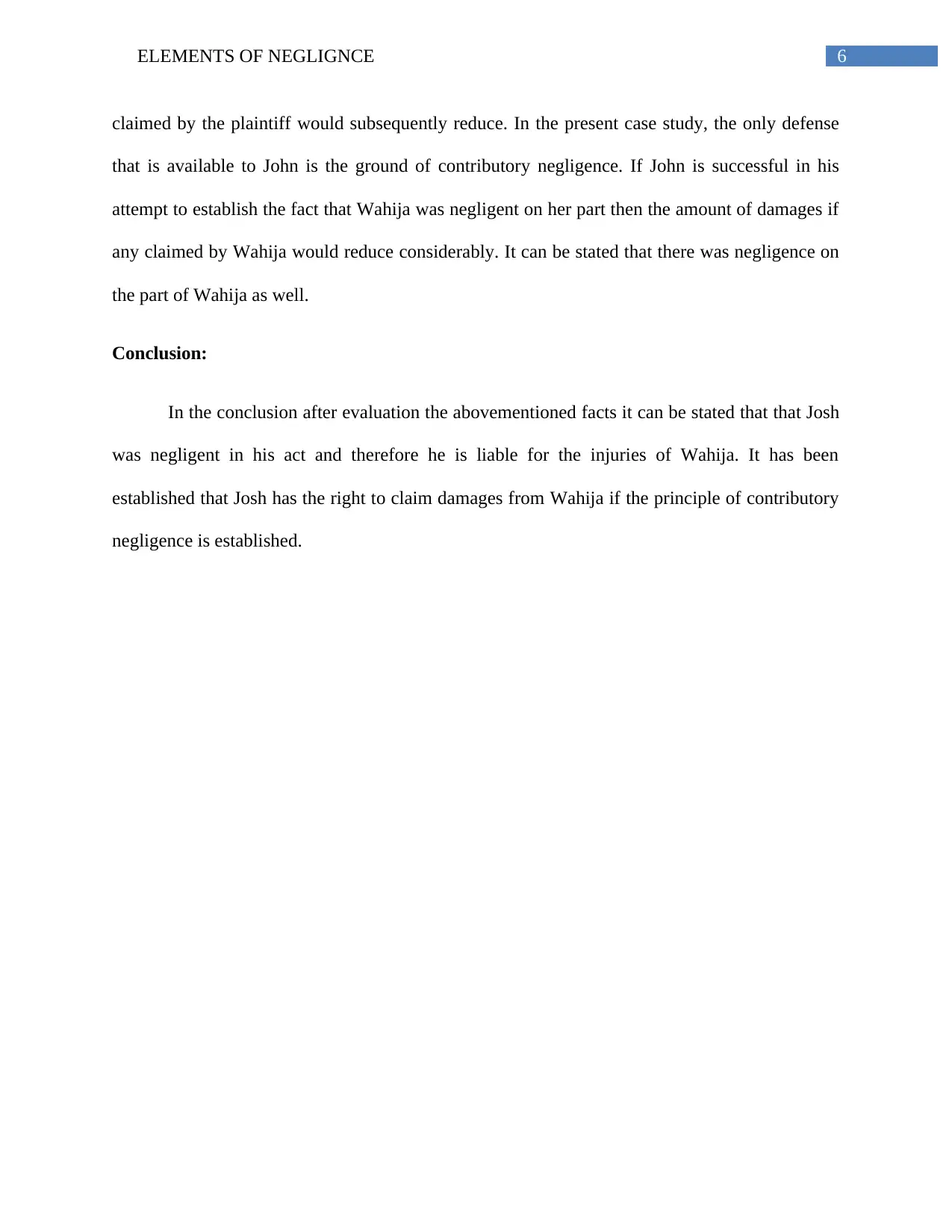
6ELEMENTS OF NEGLIGNCE
claimed by the plaintiff would subsequently reduce. In the present case study, the only defense
that is available to John is the ground of contributory negligence. If John is successful in his
attempt to establish the fact that Wahija was negligent on her part then the amount of damages if
any claimed by Wahija would reduce considerably. It can be stated that there was negligence on
the part of Wahija as well.
Conclusion:
In the conclusion after evaluation the abovementioned facts it can be stated that that Josh
was negligent in his act and therefore he is liable for the injuries of Wahija. It has been
established that Josh has the right to claim damages from Wahija if the principle of contributory
negligence is established.
claimed by the plaintiff would subsequently reduce. In the present case study, the only defense
that is available to John is the ground of contributory negligence. If John is successful in his
attempt to establish the fact that Wahija was negligent on her part then the amount of damages if
any claimed by Wahija would reduce considerably. It can be stated that there was negligence on
the part of Wahija as well.
Conclusion:
In the conclusion after evaluation the abovementioned facts it can be stated that that Josh
was negligent in his act and therefore he is liable for the injuries of Wahija. It has been
established that Josh has the right to claim damages from Wahija if the principle of contributory
negligence is established.
Paraphrase This Document
Need a fresh take? Get an instant paraphrase of this document with our AI Paraphraser
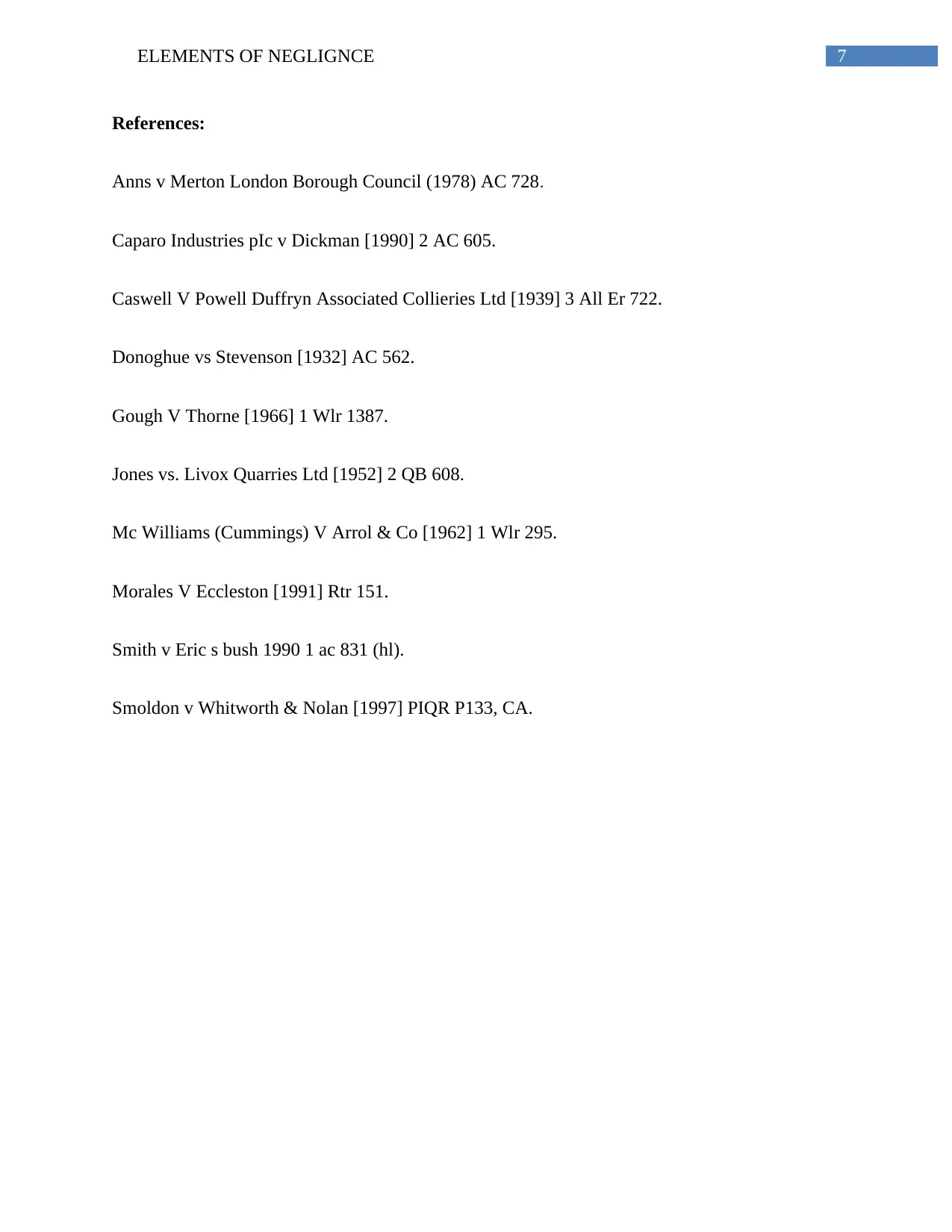
7ELEMENTS OF NEGLIGNCE
References:
Anns v Merton London Borough Council (1978) AC 728.
Caparo Industries pIc v Dickman [1990] 2 AC 605.
Caswell V Powell Duffryn Associated Collieries Ltd [1939] 3 All Er 722.
Donoghue vs Stevenson [1932] AC 562.
Gough V Thorne [1966] 1 Wlr 1387.
Jones vs. Livox Quarries Ltd [1952] 2 QB 608.
Mc Williams (Cummings) V Arrol & Co [1962] 1 Wlr 295.
Morales V Eccleston [1991] Rtr 151.
Smith v Eric s bush 1990 1 ac 831 (hl).
Smoldon v Whitworth & Nolan [1997] PIQR P133, CA.
References:
Anns v Merton London Borough Council (1978) AC 728.
Caparo Industries pIc v Dickman [1990] 2 AC 605.
Caswell V Powell Duffryn Associated Collieries Ltd [1939] 3 All Er 722.
Donoghue vs Stevenson [1932] AC 562.
Gough V Thorne [1966] 1 Wlr 1387.
Jones vs. Livox Quarries Ltd [1952] 2 QB 608.
Mc Williams (Cummings) V Arrol & Co [1962] 1 Wlr 295.
Morales V Eccleston [1991] Rtr 151.
Smith v Eric s bush 1990 1 ac 831 (hl).
Smoldon v Whitworth & Nolan [1997] PIQR P133, CA.

8ELEMENTS OF NEGLIGNCE
⊘ This is a preview!⊘
Do you want full access?
Subscribe today to unlock all pages.

Trusted by 1+ million students worldwide
1 out of 9
Related Documents
Your All-in-One AI-Powered Toolkit for Academic Success.
+13062052269
info@desklib.com
Available 24*7 on WhatsApp / Email
![[object Object]](/_next/static/media/star-bottom.7253800d.svg)
Unlock your academic potential
Copyright © 2020–2025 A2Z Services. All Rights Reserved. Developed and managed by ZUCOL.





